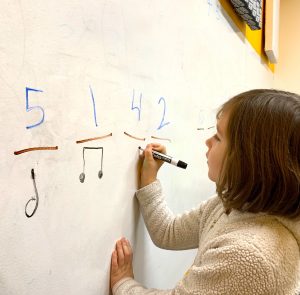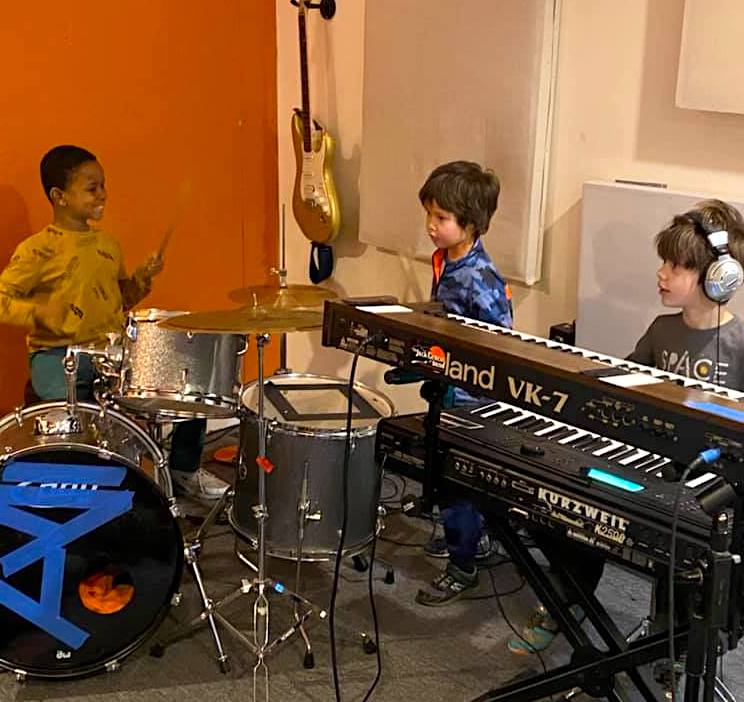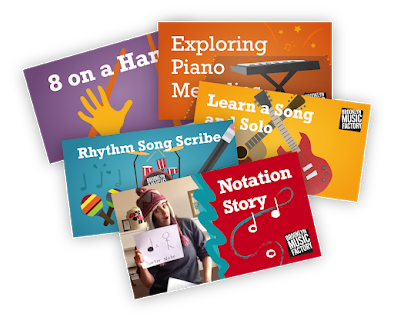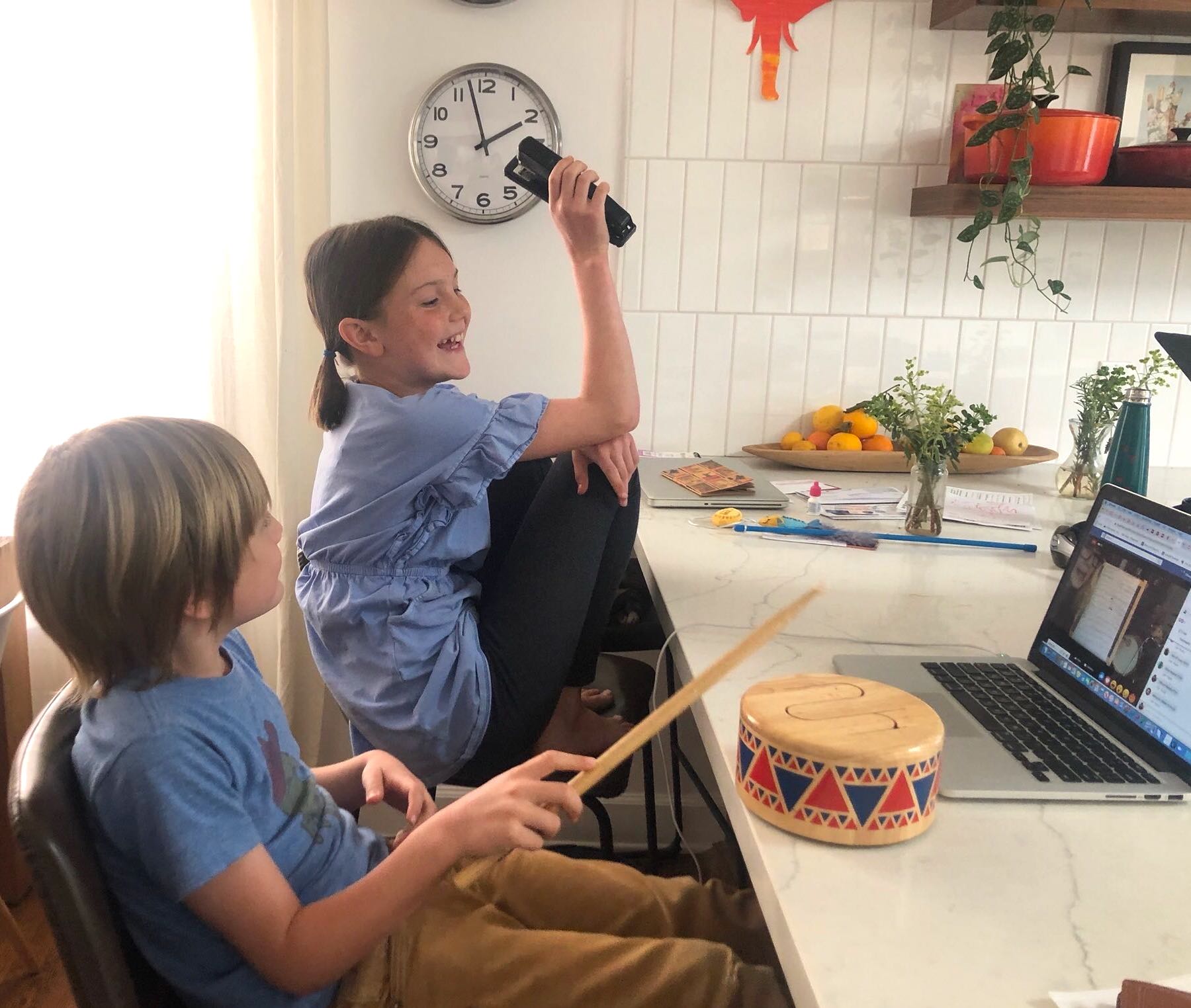We play lots of games– at Brooklyn Music Factory—we call them BLAM (that’s short for Big Lessons About Music) games. Melody Memory Maker is one of our online music theory games for kids, and it’s fun, creative and inspiring.
Read on to learn more about Melody Memory Maker from Nate, BMF co-founder—and prolific game creator!
Who Should Play Melody Memory Maker?
All of Brooklyn Music Factory’s in-person and online music theory games, including Melody Memory Maker, are designed to challenge kids from age four to 17! With fifteen levels—broken into three groups—Melody Memory Maker is a game that a young musician can spend years playing, developing their skills all along the way.
Kids ages four to eight start at level one, playing the game by singing or on a keyboard. (So no instrument required!) Then kids ages nine to 12 move on the intermediate series—levels six through 10. And then finally, kids ages 13 and up are ready to work on the really advanced levels, 11 through 15, which are perfect for pre college and college students. Advancing from level to level and group to group can take years. That’s the whole point.
Brooklyn Music Factory is an accelerated ear training and theory program, so we’ve created online music theory games for each age group and kids can move at the pace that’s best for them.
Why Play Melody Memory Maker?
I’m going to explain what a student will learn when they play this game, and I’m going to explain it with an analogy. Oftentimes, we describe music as a language. Just like we build fluency in spoken languages—English, Spanish, Mandarin, etc.—we can also build fluency in the language of music. Melody Memory Maker is a tool that teaches and develops one specific music fluency: melody.
What is a Melody?
What is melody? Simply defined, melodies are notes that are played one after another. So, when you think about a melody, picture a horizontal line of music. One note after another after another. Melodies can be broken up into short little phrases or motifs, like bum, bum, bum, bum, bum, bum or dot, dot, dot, dot. And those phrases can be strung together to create longer and longer melodies.
Melody Memory Maker introduces students to the concept of listening to a melody deeply, as it moves horizontally through time. Melody Memory Maker always starts with one note, and then adds another note, and another and another and another, gradually stretching the student’s musical focus, and specifically their melodic focus. Can they hear a melody that’s getting longer and longer and longer, and remember that melody, be able to sing or play the melody back on a keyboard, guitar or bass?
Ear Before Eye Approach
Brooklyn Music Factory uses what we call an “ear before eye” approach, meaning we want our students to be comfortable learning with their ears. Why? Because music is an aural art form meant to be listened to. Learning how to listen better and with more focus, and ultimately being moved by what you hear, is essential for musicians.
Melody Memory Maker challenges students as young as four to listen really intently to a set of pitches in a specific order. Melodies move in specific orders and follow patterns, and this online music theory game teaches students from a very young age to begin to hear and recognize melodic patterns in music.
Now, the focus part of Melody Memory Maker is a skill that is essential for playing and collaborating with other musicians. As we mature as musicians—regardless of the instrument we play—we are learning how to focus on the other instruments in the band. Sometimes we need to focus on the singer, and what they are singing, in order to know exactly what we’re supposed to do on the piano. And conversely, sometimes the singer needs to focus entirely on the melody being played by the guitar player to know when to start singing.
Using Music Games to Find Patterns
Melody Memory Maker really helps musicians learn and understand the power of focus. The game stretches the student’s focus and, as they pass each level, the game asks the musician to listen a little bit more closely. And a little bit longer.
Melody Memory Maker reminds me of the game Simon. Remember that awesome game where you had four colors and four buttons to push? Melody Memory Maker is like Simon on steroids. It gets more and more complex, meaning there are more and more buttons and more and more colors that students need to follow and remember. Think of melodies as combinations of different colors. Melody Memory Maker asks students to remember the colors in a very specific order in a specific pattern, and those patterns get harder and harder with each level.

What Does Melody Memory Maker Mean for a Musician?
Melody Memory Maker reminds every musician that there are two key skills that they’re developing around melody.
Number one: They’re beginning to hear melodic patterns and recognize the shapes of the melodies. I don’t need to see the music on a page, because I can hear it and know how to translate what I’m hearing to my instrument. Being able to do that allows two musicians to have a much more fluid “conversation” when they play together. When they share a vocabulary—in this case, melodic patterns—they can converse quickly and easily.
Number two: Melody Memory Maker helps a musician learn to focus for the entire length of a song. The average pop song is about three to five minutes long. That may not seem like a long time for you, but, for a four or five year old, focusing for more than 30 seconds on a melody or a rhythm or a harmony is asking a lot. Melody Memory Maker slowly stretches a musician’s focus so they are ultimately capable of being 100% engaged for the entire three or five or 10 minutes of a song.
“When they [musicians] share a vocabulary—in this case, melodic patterns—they can converse quickly and easily.”
What’s Next?
What if you’re doing great at Melody Memory Maker? You’ve passed all five beginning levels, and you’re moving into the intermediate levels?
You can always couple Melody Memory Maker with another online music theory game like Rhythm Song Scribe or Complete the Composition. With Rhythm Song Scribe, you’re combining your ability to hear patterns of melodies with your ability to hear rhythms or lengths of pitches. Picture melodies as combinations of colors. How long does that color orange last before it goes to the color blue?
Tying in Other Online Music Games
In Complete the Composition, the teacher plays a short melodic idea, and then challenges the student to answer with their own melodic idea. The game encourages the student to listen to the teacher play a melodic pattern and then improvise or compose their own melodic pattern in response. That’s asking the student to hear the pitches or colors in patterns in the teacher’s melody and to stay focused long enough to respond with their own.
Developing Fluencies Through Online Music Theory Games
We think of BLAM games in terms of the categories or music fluencies that they strengthen—melody, harmony, rhythm and songwriting. Our musicians play different BLAM games to develop different fluencies, learning how to combine and build on them along the way.
So, rather than thinking, “I want to complete all 15 levels of Melody Memory Maker,” we instead try to make sure that our students are growing in all four fluencies at the same pace. So, as a student passes level five of Melody Memory Maker, we’re also working with them to pass level five of Wait a Second or Rhythm Song Scribe or Beat Detective.
There are so many games to build melody, harmony, rhythm and songwriting fluencies, and we want our students to always work on fluencies in all four categories.

So, rather than thinking, “I want to complete all 15 levels of Melody Memory Maker,” we instead try to make sure that our students are growing in all four fluencies at the same pace.
Where Does Melody Memory Maker Fit in the Big Picture ?
At Brooklyn Music Factory, we believe a Musician’s Journey should last seven to 10 years. So when a student starts a MiniKeys class with us at age four and plays Melody Memory Maker, or any one of our other Big Music Games, we think, “How are we going to help this student grow musically for seven to 10 years, before they head out into the world on their own as songwriters and collaborators and confident creatives?”
10 Years of Music Games!?
The most important thing to keep in mind with these games is that they are leveled very intentionally to last seven to 10 years. Our students love these games because they’re really, really fun and engaging to play. Most importantly, from our standpoint as we develop the curriculum, we want students to keep playing games every single year, year after year, so that they’re always strengthening their fluencies as musicians and communicators. We don’t want them—three or four years into their journey—to get hyper-focused on just becoming a really good technician on an instrument. We want to make sure that the student is always balancing music fluency with technical ability.
Learning Music as a Language
An easy way to think about this is when we’re learning a language, whatever language it is, we want to always be building a vocabulary and we want to share that vocabulary in group contexts. We’re not just technically capable on an instrument. We also understand what we’re playing on the instrument and are able to hear it in our head. We call that the “inner ear.” At each stage of growth over those seven to 10 years, we want students to be able to hear a sound, and then go straight to their instrument, and realize that sound on their instrument. Our students can do that because they understand and have categorized all of these amazing melodies and chord progressions and lyrical ideas, the rhyming patterns and song forms.
As they grow as musicians, they are constantly building these fluencies and developing an understanding of what they all mean and how to apply them on their instruments. Ultimately, they can use their instrument to collaborate with other musicians and be creative in their community.
“We don’t want them—three or four years into their journey—to get hyper-focused on just becoming a really good technician on an instrument.
We want to make sure that the student is always balancing music fluency with technical ability.”
A Special Note for Music Teachers Using Online Music Theory Games
Music teachers around the world play our online music theory games and ask all the time, “How do I implement this into my lesson plan? Are BLAM games appropriate for a classical program? Does the approach work if I teach only bluegrass?”
Here’s how we do it at Brooklyn Music Factory:
Our lesson architecture is structured very simply, and every single one of our classes or private lessons always includes at least one fluency game, and usually just one. So, for example, if I’m teaching a private piano lesson to an intermediate student, I will start with an improvisation game called “A Free and Easy Duet.” That’s just five minutes to say hello, using the language of music, to see how they’re doing and communicate without words.
Then I move straight from the improvisation into a fluency, BLAM or Big Music Game. The game, such as Melody Memory Maker, will last about 10 minutes, and then I’ll move into the song the student is learning or composing. If I’m working with a student on melody, then Melody Memory Maker feeds perfectly into an exercise where the student has to compose their own melody. Or maybe a piano player is learning how to solo over certain chords. I’ll use Melody Memory Maker as a starting point to talk about specific scales or melodic patterns they can use.
Finally, I always have the same simple intention: to meet the student where they are in their journey with melody, rhythm, harmony, or songwriting. I’ll challenge the student to work on melody or work on harmony or work on rhythm and get a little bit more comfortable, and a little bit more confident, being able to hear sound. I encourage them to analyze the sound using their musical mind, and then apply it to their instrument.
“I always have the same simple intention: to meet the student where they are in their journey with melody, rhythm, harmony, or songwriting.”
Want to try out some of our online music theory games? Play for free on BMFTV! It’s super easy to login and there are tons of games for all ages–even adults.
P.S. BMFTV is a great free resource for music teachers!!


